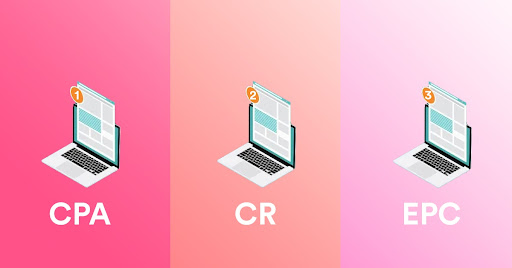
CPA, CR, and EPC are critical metrics in affiliate marketing. Understanding CPA or CR or EPC helps you choose the optimal model for maximizing profits, improving campaign efficiency, and achieving better results.
Most affiliates run a bunch of campaigns with varying success. Sometimes those campaigns are a success but most of the time they don’t live up to the expectations that are set by their creators. This is a normal part of affiliate marketing but what decides if your campaign will be a success or failure?
Well, there are a lot of metrics that you can look at, and today we will present you with some of the most important ones. These are CPA, CR, and EPC. We will explain what each metric is good for and how you should analyze them to get insight into your campaign’s health at a glance!
So let’s not waste time and let’s get to the most important things you need to look at when looking at your campaign’s health!
What CPA Can Tell You
If you spent any time working in the affiliate marketing industry you should be acquainted with what CPA is and what it stands for. CPA or Cost Per Acquisition / Action is a type of conversion rate marketing.
The sum a business will pay for an advertisement that leads to a sale is referred to as the cost per acquisition. Similarly, cost per action refers to the fee charged by a business for an advertisement that leads to a certain action, such as signing up for a newsletter or downloading an eBook. The business only pays for adverts that result in sales in either kind of CPA.
CPA is important for businesses when they are trying to promote their products on external websites and platforms through affiliate programs. CPA advertising is usually considered to be low risk and high reward for advertisers as they only need to pay affiliates if they manage to make a sale of their product or desired action.
For most affiliates, CPA is the main metric that they consider when reviewing their campaigns. Their CPA will tell them how much money they need to spend on their campaigns to make a sale. If that number is bigger than the payout the business offers them for each sale, then they are going into minus with their campaigns. If their CPA is lower than the payout the owner offers, then they are making money.
So, this number can give you a great glance at how your campaigns are doing globally. You can see exactly which are making you money and which of them are not. This is great to some extent, but it lacks a huge thing. Context.
With CPA you don’t exactly know why your campaigns are performing the way you are. Sure, you can find out some of the things through AB testing or other methods of splitting your campaigns, but the real reasons behind their success or failure will most likely stay hidden from you without some serious analysis.
Lowering your CPA is done through some of the following methods:
- Optimizing your Landing pages
- Retarget audiences that previously converted or were close to doing so
- Run campaigns on people who left their cart without buying anything at the end
- Focus on audiences that generate sales and cut off the ones that don’t
- Optimize your keywords and targeting
- Optimize the checkout for smoother buying
- Optimize your creatives
What Is CR Important For

Conversion Rate or CR is a simple metric. It takes the number of conversions your campaigns achieved and divides it by your total visitors. This gives you a number that represents what percentage of your visitors convert and make you money.
Tracking this number is a popular thing in affiliate marketing and there is hardly anyone working today not doing exactly that. Unlike CPA that shows you a global number, CR is much more detailed. You can see exactly which one of your ads, ad sets, or campaigns is doing well and which are not, and you can deduct in most cases why that is.
If you try doing split testing on your ad sets, you will quickly notice that your CRs can be wildly different from ad to ad. Some will do incredibly well, while others will have low numbers. Understanding what this number is and why it’s so low or high is the difference between regular affiliates and the pros.
When you find a winning combination of ads that has a high CR rate, you can then try and work on your profitability. You can add more sale items to your campaigns, try selling bundles, or diversify in more ways so you can get more money out of each visitor that converts. This will then boost your bottom line much more than if you adjusted for the only CPA from the beginning.
Optimizing your CR can be done in multiple ways. You should first identify your campaign goals so that you have something to work towards. You then need to identify patterns in why your visitors are or are not converting. When you manage to do this, focus your time and energy on improving the things that are making your campaigns better, and cut off things that are hurting your CR. This is most often done through some sort of A/B Testing.
Why EPC Is A Valuable Metric
Earnings Per Click or EPC is a popular way of analyzing campaign success in the affiliate world. It is similar to CPA and CR in some ways. You will get a detailed report on how much money, on average, you earn from people that click on your links.
This number is great if you have already optimized your CPA and CR, but if you haven’t done that yet it can often be misleading. With every affiliate marketing campaign, there are moments where one visitor will buy much more than the rest, and this can mess up your EPC measurements. You won’t get an exact number on how your visitors react to which campaign, you just get a number that averages the numbers.
This can leave a lot of space for optimizations on the table. It’s much better to optimize for CPA and CR so that you ensure that your audience pool is as large as possible and then optimize EPC so you can get the most out of them.
Increasing your EPC can be done by including more CTA’s, improving ways of earning more money from a single person, and linking to the highest bidder so that you get the most out of each conversion.
Which One Of These Is The Best Metric To Look At?

All of these metrics have their pros and cons. CPA is great for generalizing your campaigns and ads. You will know at a glance how much you need to spend on average to get a sale. This number can sometimes be unreliable when taken only by itself as it only gives you the price you need to pay to acquire a conversion.
Similarly, EPC has a problem with reliability as well. You will know how much you get from your visitors on average, but not where they are coming from and what made them convert in the first place. This makes it hard to optimize your campaigns to maximize profits at times.
CR on the other hand is a bit different in most ways. It gives you a number that shows what percentage of the audience you advertise to is interested in your products in the first place. With this knowledge you can target the more interested folks, and skip spending money on those who you can see are clearly not interested. While this is by far the best metric out of these because you can learn exactly how effective your campaigns are, it’s not perfect.
Without checking for yourself with other metrics, it is hard to see just how profitable those campaigns are. Maybe their conversion rate is good, but the average customer spends the smallest amount on their purchase. Though, this is very rare and is more likely to be a statistical error.
Final Words
Focusing on only one metric and tracking it can be detrimental. There are a lot of metrics that an affiliate should take a look at then determining just how well their campaign is doing. Judging a campaign’s health by only looking at one metric can give you lackluster information and lead you to not make the best choice of action in a given moment.
If you can, use multiple metrics to determine your future choices, but if you only have access to one, CR is probably the best one to take into account by itself!
Please log in to Facebook to access the comments section